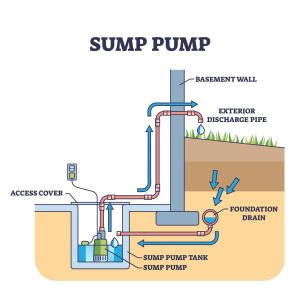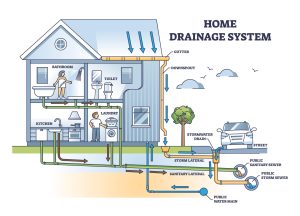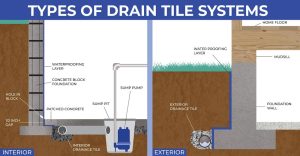


Interior and Exterior Drainage Systems in Eastern Ontario
Why Drainage Systems Matter
Drainage is one of the most important, yet often overlooked, parts of a home. Proper drainage protects the foundation, prevents basement flooding, and manages surface water during heavy rains or spring thaws. In Eastern Ontario — where clay soils, limestone bedrock, and freeze-thaw cycles can create drainage challenges — both interior and exterior systems play a critical role in keeping homes safe and dry.
Exterior Drainage Systems
Exterior drainage works to move water away from the home before it reaches the foundation.
1. Grading and Sloping
-
Description: The land around a home is graded to slope away from the foundation.
-
Pros: Simple, cost-effective, first line of defense.
-
Cons: Requires ongoing maintenance; settling soil or landscaping changes can compromise grading.
2. Eavestroughs and Downspouts
-
Description: Collect roof runoff and direct it away from the home. Extensions, splash pads, or buried pipes may carry water farther.
-
Pros: Essential for managing rainwater and snowmelt.
-
Cons: Must be kept clean and properly pitched; downspouts too close to the house can worsen problems.
3. French Drains (Exterior Weeping Tile)
-
Description: Perforated pipe buried around the perimeter of the foundation, covered with gravel and filter fabric. Collects groundwater and directs it to a sump pump or storm drain.
-
Pros: Highly effective at controlling groundwater around foundations.
-
Cons: Expensive to install or repair (often requires excavation).
4. Swales and Ditches
-
Description: Shallow, sloped channels directing surface water away from homes and driveways.
-
Pros: Common in rural properties, handles large volumes of runoff.
-
Cons: Requires space and regular maintenance.
5. Dry Wells and Rain Gardens
-
Description: Underground pits or landscaped areas designed to collect and absorb stormwater.
-
Pros: Eco-friendly, reduces runoff.
-
Cons: Limited capacity, not suitable for all soil types.
Interior Drainage Systems
Interior drainage is the second line of defense, managing water that gets into or under the foundation.
1. Interior Weeping Tile (Perimeter Drain)
-
Description: Perforated pipe installed inside along the basement footing, covered in gravel, and connected to a sump pump.
-
Pros: Relieves hydrostatic pressure, redirects water safely out.
-
Cons: Requires breaking basement slab for installation; disruptive and costly retrofit.
2. Sump Pumps
-
Description: Pumps collect water from weeping tiles or drain tiles and discharge it outside.
-
Pros: Critical in areas with high water tables; protects basements from flooding.
-
Cons: Dependence on electricity; may require battery backup.
3. Floor Drains
-
Description: Drains built into basement or utility room floors, connected to storm or sewer systems.
-
Pros: Provides emergency drainage for leaks.
-
Cons: Can backflow if not fitted with backwater valves.
4. Backwater Valves
-
Description: Prevents sewer water from backing up into the home during heavy rains or municipal overload.
-
Pros: Essential protection in urban areas.
-
Cons: Needs periodic inspection and maintenance.
5. Interior Channel Drains
-
Description: Small surface channels cut into basement floors to collect water and guide it to a sump.
-
Pros: Useful for spot problems or partial retrofits.
-
Cons: Less comprehensive than full perimeter systems.
Climate and Regional Considerations
-
Clay soils in Belleville, Quinte, and Hastings can trap water against foundations, making both exterior weeping tile and sump systems essential.
-
Limestone bedrock in Prince Edward County can shift water unpredictably, requiring well-designed grading and sump solutions.
-
Freeze-thaw cycles make proper downspout extensions critical to avoid ice buildup near foundations.
-
Many older homes in the region predate modern drainage standards and may require retrofits to prevent recurring water issues.
Key Takeaways for Buyers and Homeowners
-
Exterior systems (grading, weeping tile, eavestroughs) prevent water from reaching the foundation.
-
Interior systems (weeping tile, sump pumps, backwater valves) manage water that gets in.
-
Both are often needed in Eastern Ontario’s climate to ensure a dry, healthy basement.
👉 In summary, effective drainage relies on a combination of exterior and interior systems working together — from simple grading and gutters to full perimeter drains and sump pumps. For homeowners in Eastern Ontario, these systems are critical investments in protecting foundations, basements, and overall property value.

